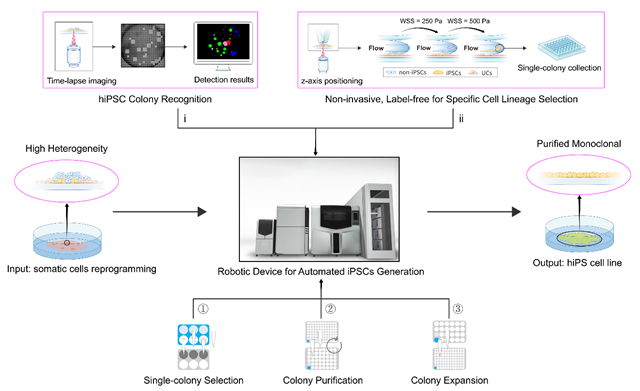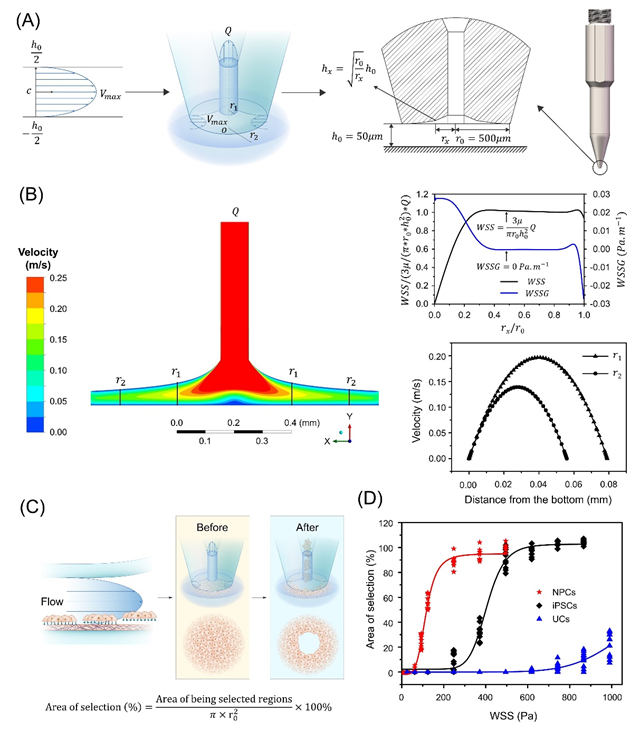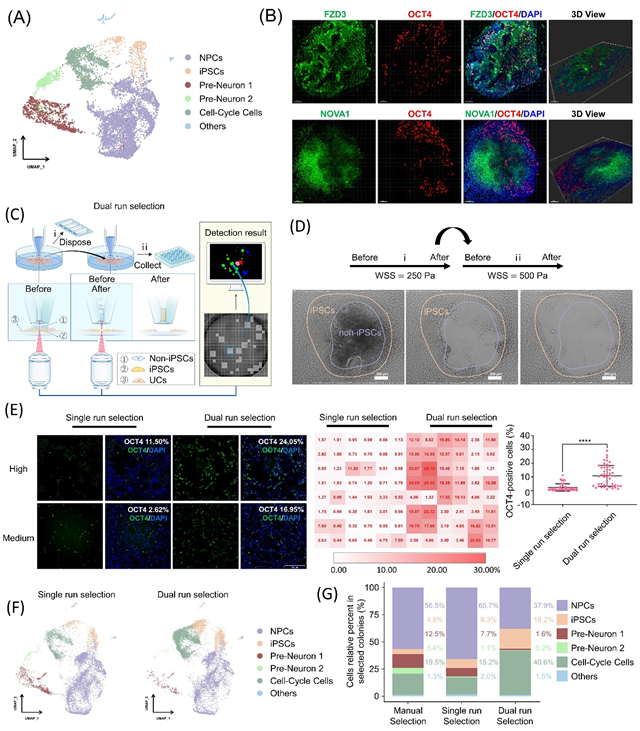Researchers Make New Progress in Studying Automated Monoclonal Lineage Cells Selecting Technology
Despite the broad prospects for the application of lineage-specific cells in regenerative medicine, traditional methods for obtaining monoclonal lineage cells through manual manipulation are time-consuming, labor-intensive, and generally inefficient. Furthermore, these methods cannot acquire monoclonal lineage cells in a label-free, enzyme-free, and non-invasive manner. Although microfluidic technology can improve the efficiency of lineage cell harvesting, it cannot obtain cell monoclonals based on lineage specificity. Therefore, developing automated technologies that can efficiently enrich monoclonal lineage cells is particularly important. Since changes in the adhesion between cells and the cell-matrix are a key step in the destiny of lineage cells, regulating fluid shear stress can enable the separation/selection of monoclonal lineage cells with different adhesion characteristics in a label-free, enzyme-free, and non-invasive manner. This strategy can be used for the engineering acquisition of monoclonal cells based on cell type specificity.
Recently, the team led by Professor ZHANG Xiao at the Guangzhou Institutes of Biomedicine and Health (GIBH), Chinese Academy of Sciences, proposed an automated monoclonal lineage cell acquisition strategy based on innovative structured microfluidics (PTMS-FLOW). This approach, which operates in a label-free, enzyme-free, and non-invasive manner during the somatic cell reprogramming process, has achieved the automated acquisition of monoclonal cells for specific lineages, and developed a complete cell monoclonal acquisition technology based on PTMS-FLOW. This original strategy was successfully implemented on the Automated Stem Cell Induction and Culturing System independently developed by GIBH, improving the efficiency and purity of obtaining human induced pluripotent stem cells (hiPSCs) monoclonals, enhancing system robustness, and shortening the period for continuous purification of hiPSCs (sub-cloning) after somatic cell reprogramming. The research findings were published online in Research, titled “Selecting Monoclonal Cell Lineages from Somatic Reprogramming Using Robotic-Based Spatial-Restricting Structured Flow.”
In the study, the researchers analyzed the expression levels of cell adhesion molecules during somatic cells reprogramming processes and found that the expression levels of pluripotency genes were negatively correlated with the expression of the Integrin genes and positively correlated with the expression of the Cadherin genes. Since Integrins are key adhesion molecules for interactions between cells and the extracellular matrix (ECM), and Cadherins are important molecules for cell-to-cell connections, this suggests that during the transition of somatic cell reprogramming to pluripotent stem cells, connections to the ECM may weaken while connections between cells may strengthen. To test this hypothesis, the authors conducted further verification through parallel-plate flow chamber (PPFC) experiments and immunofluorescence experiments. The experimental results were consistent with the hypothesized expectations, and the PPFC experiments preliminarily proved that fluid shear stress could be a promising technique for separating/selecting specific types of adhesive cells.
Subsequently, based on the principles of fluid dynamics, the authors designed a micro-needle structure capable of generating localized structured microfluidics (PTMS-FLOW). The mechanical team overcame challenges in flow field effects and multi-curved surface processing, repeatedly verifying the processing structure, ultimately achieving specific lineage cell selection based on spatial restrictions using PTMS-FLOW. The study demonstrated that PTMS-FLOW could adjust to different cell type adhesion forces under constant conditions on the Z-axis-h0, enabling the label-free, enzyme-free, non-invasive, and non-contact selection of different lineage cells. This research proved that structured microfluidics is an automatable technological path for separating/selecting specific lineage type adhesive cells, providing a theoretical basis for further automated acquisition of monoclonal lineage cells.
To apply this strategy for automated acquisition of specific lineage cells during somatic cell reprogramming, the author team overcame challenges in mechanical module control and precise scheduling. Combining cell optical imaging and adaptive algorithms, they achieved precise manipulation of the functional base of the microstructure and the spacing and horizontal displacement of the Z-axis between cells and monoclonal lineage cells, thereby ensuring precise control of PTMS-FLOW on monoclonal lineage cells, achieving the goal of rapidly acquiring hiPSCs cell monoclonals in the complex lineage during somatic cell reprogramming.
Furthermore, by leveraging the precise fluid control capability of the automated overall equipment technology, the author team designed a Dual Run Selection mode. By using two different intensity shear stresses to obtain lineage cells with different adhesion characteristics, they achieved specific selection of hiPSCs lineage cell monoclonals at specific spatial locations, and provided sub-cloning capabilities for downstream specific amplification of hiPSCs.
This established overall equipment technology significantly reduces the time and labor costs in the process of generating lineage cells, making the acquisition and cultivation of lineage cells simpler. This research provides a new technical solution for the automated production of specific lineage cells for clinical interventions and offers more automated tools for obtaining lineage cells for foundational research in regenerative medicine, thereby promoting the basic research and practical application of the field from both technical and methodological perspectives.

Overview of the automation acquisition strategy for lineage cells (Image by GIBH)

Studying the adhesion and separation effects of different lineage cells using PTMS-FLOW (Image by GIBH)

Based on the differences in cell adhesion, PTMS-FLOW was utilized to select monoclonal pluripotent stem cells during reprogramming (Image by GIBH)
Contacts:
Xiao Zhang, Ph.D., Principal Investigator;
Guangzhou Institutes of Biomedicine and Health, Chinese Academy of Sciences, Guangzhou, China, 510530.
Email: zhang_xiao@gibh.ac.cn